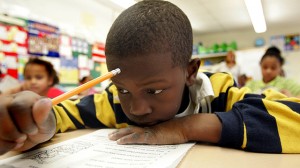
Second grade student Kaign Groce, 7, reads a book Wednesday, Feb. 1, 2006, during a literacy class at the John Fenwick Elementary School in Salem, N.J. (AP Photo/ Jose F. Moreno)
This post first appeared in The Nation.
Comprehensive data released Friday by the US Department of Education’s Office for Civil Rights offers a striking glance at the extent of racial inequality plaguing the nation’s education system.
Analysts found that black, Latino and Native American students have less access to advanced math and science courses and are more likely to be taught by first-year instructors than white students. Black and Native American students are also suspended and expelled at disproportionate rates.
For the first time in history, the Education Department also examined school discipline at the pre-K level, finding that black students as young as 4 years old are already facing unequal treatment from school administrators.
The Education Department released four papers with the data, analyzing inequality in school discipline, early learning, college readiness and teacher equity (PDFs). Here’s a breakdown of some of the key findings, taken straight from those papers. During the 2011–12 school year:
- Black students accounted for 18 percent of the country’s pre-K enrollment, but made up 48 percent of preschoolers with multiple out-of-school suspensions.
- Black students were expelled at three times the rate of white students.
- American Indian and Native-Alaskan students represented less than 1 percent of students, but 3 percent of expulsions.
- Black girls were suspended at higher rates than all other girls and most boys.
- American Indian and Native-Alaskan girls were suspended at higher rates than white boys or girls.
- Nearly one in four boys of color, excepting Latino and Asian American students, with disabilities received an out-of-school suspension.
- One in five girls of color with disabilities received an out-of-school suspension.
- A quarter of the schools with the highest percentage of black and Latino students did not offer Algebra II.
- A third of these schools did not offer chemistry.
- Less than half of American Indian and Native-Alaskan high school students had access to the full range of math and science courses, which consists of Algebra I, Geometry, Algebra II, calculus, biology, chemistry and physics.
- Black and Latino students accounted for 40 percent of enrollment at schools with gifted programs, but only represented 26 percent of students in such programs.
- Black, Latino and Native American students attended schools with higher concentrations of first-year teachers (3-4 percent) than white students (1 percent).
- Black students were more than three times as likely to attend schools where fewer than 60 percent of teachers meet all state certification and licensure requirements.
- Latino students were twice as likely to attend such schools.


